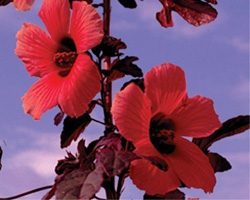Red Night Blooming Hibiscus
Category: Pond Plants

Facts about Red Night Blooming Hibiscus plant. "Scientific name for Red Night Blooming Hibiscus plant is Hibiscus acetosella". Red Night Blooming Hibiscus plant refers to an angiosperm from the genus Hibiscus L. This name is derived from Latin which means a sour taste especially when eating the young leaves of this hibiscus plant. It is also referred to as Cranberry hibiscus, false roselle, African rosemallow, red leaved hibiscus or maroon mallow.
The Red Night Blooming Hibiscus plant is one of the many species of the hibiscus that is found in the tropics. It can be easily spotted in open areas, forest clearings, abandoned fields and marshes. It is a member of the hardy hibiscus which is a perennial group. The Red Night Blooming Hibiscus plant can tolerate chilly and colder conditions, has large flowers and lasts long. In one season, the plant can grow about 35 to 67 inches (90 to 170 cm) in height and 30 inches (75 cm) in width. Ideal water conditions are 65 to 80° F (18 to 26 cel) and 6.5 to 7.5 pH
Physical Characteristics of Red Night Blooming Hibiscus plants
The Red Night Blooming Hibiscus plants has foliage which resembles that of Japanese maple. It has dicot leaves that vary in their form and shape. Some are un-lobed while others are lobed. The color of the leaf is usually seen as a dark maroon but at times it can develop into a patchy red green appearance. The stipules are often linear and can measure up to 19/32 inches (1.5 cm) in length. The petioles and the stems are generally smooth and devoid of any hair. The flowers of the Red Night Blooming Hibiscus plants which are usually solitary sit at the top of a long pedicel. The color of the flowers is often dark maroon. The red night blooming hibiscus is self pollinating and produces seeds that are dark brown measuring 3 to 2.5 mm.
Geographical Distribution of Red Night Blooming Hibiscus plants
This species of hibiscus was first spotted by French botanists in 1896 around southern DR Congo, Zambia and Angola region. From there, it is believed to have been transferred to south-East Asia and Brazil to be used as food for slaves. The Red Night Blooming Hibiscus plants popularity has now grown in Brazil even more compared to its original homeland in Africa.

 Back To Category Pond Plants
Back To Category Pond Plants